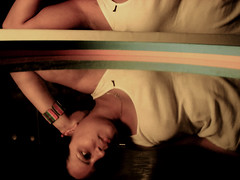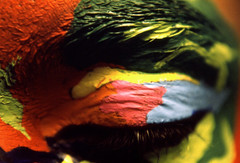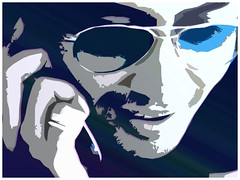Wednesday, March 24, 2010
Saturday, October 20, 2007
PERFECT! Simply perfect...
I am not normally a fan of floral shots. But this shot, shot by my very talented brother in-law Jason Armstrong is a stunning example of excellent control of exposure to dramatise the overall composition...
EXCELLENT...! One on my favourite shots.
•~•~•~•~•~•~•
Kelisa ~ Dr. Bore
I love this spot by barney chua... As a director all I can say is that this spot simply extravagant. Excellent.
••••••••
Thursday, October 11, 2007
TMnet ~ Sleeping Beauty
This was one of the first few ads I did in my career.. It is one out of four spots in a campaign to promote a Game Show, sponsored by TMnet.
The game show was called 'How Well Do You Know Your Partner...?'... The core idea of this campaign was to take familiar fariy tales and twist the endings. In this instance, we see sleeping beauty sleeping way past 100 years waiting for her Prince Charming. Than we ask the question, 'How Well Do You Know Your Partner...?'.
They were fun boards to work on.
••••••••••
The HangOut
This is a spot we worked on for fun for Kevin & Merilyn's pet store...
I found it on YouTube...
••••••
Thursday, June 16, 2005
MAKE a photograph ~ don't "take” a snapshot!
We have to ask ourselves: What do we want to emphasize in our picture? How will we direct our viewers’ eye to our subject? If it's an outdoors photograph, how will we separate our main subject from any other distracting elements in our photograph? At which angle should we shoot? Is it important to establish place in this photograph (i.e., is it important for the viewer to know where our subject is? Or do we want to hide the location)? If we're shooting people, what is our victim’s least appealing feature (i.e., a large nose, a bald head, pot belly, lots of wrinkles, etc.:)? How can we hide or de-emphasize it? What's our subject's most appealing feature (i.e., eyes, profile, smile, boobs - oops! sorry, I couldn't resist:)? How can we emphasize the attractive aspects of our subjects? These are the questions photographers have to ask, before we shoot.
THINK before you shoot! MAKE a photograph - don't "take” a snapshot! Review the "Tips" in this auction; take the time and thought to prepare your photo sessions long before your subject arrives! Learn to know what you want before you put film in your camera. Learn to "design” your pictures before you pick up your camera! Take a piece of paper and a pencil, and sketch out what you want in the picture you’re considering; this will be a great help in the beginning, and after a few weeks or months of doing this, you'll start to do it all in your head, and won't need the pencil and paper any more.
Is your subject a child? If so, have some colorful toys around. Is your victim a man? Have him bring a suit and some jeans to the session. Is your subject an attractive and shapely young woman? Ask her to bring a dressy outfit and a sexy outfit or a bikini. Is your subject older? Be sure to have an umbrella or softbox ready to hide the lines and wrinkles. Shooting outdoors? Avoid placing a subject in the bright sunlight (which causes squinting eyes and harsh shadows), and find some open shade to shoot in (overcast days are great for outdoor shoots). I promise you that a good photograph doesn't require the genius of an Einstein - it just takes a little thought and preparation (creativity and practice doesn't hurt either)! You don't have to study photography for 20 years, just train yourself to think before you shoot! Don't try to plan out 100 subjects all at once; think about one or two, and then use 10 rolls of film on just a few ideas. Shoot from different angles; shoot from different heights; shoot with different lighting angles; shoot with color film; shoot with black and white film; think, then shoot! Pretty soon, you'll wake up one day and realize that you've changed; you'll look at the world differently; you'll "see" things most people never even notice; one day, you'll realize that you've become something special; something different, but different in a most amazing and wonderful way; you will have become - a photographer!
~~~~~~~~~~~~~~~~~~
Saturday, March 12, 2005
Exposure
QUICKIE TECHNIQUE #1:
All meters built into all cameras are "reflection" meters; they read the light reflected by our subjects AND everything else in our viewfinder! This often causes incorrect readings, and pictures that turn out looking like doo-doo. Instead of letting our camera's meter read the exposure from our whole frame, set your built-in meter to its "spot" setting. Then, center the most Important part of your subject (i.e., the face of a person, the flower petals of a flower, the coat of a dog, etc.) in your meter's spot circle and take your reading; then, when our viewfinder's spot circle is filled with our subject and NOT with the surroundings, lock in exposure (e.g., press the shutter button half-way down), re-compose the shot, and then press the shutter button all the way down and make the exposure! I think you'll be pleased with the results!~~~~~~~~~~~~~~~~~~
Sunday, December 26, 2004
Nature oR Nuture

MirrorImage
Originally uploaded by sherIZAN.
Another key ingredient to a great shot is the eye for an angle… For the longest time I was told or much better said brain washed by what is ‘norm’ in society, that this key ingredient to great photographs is a god given talent. Something that you are born with, build it rather than acquired; nature rather than nurture. And many a times we find that this talent starts to show itself in the photographer from a tender age. But the image above clearly defies this myth...
An amazing shot… beautifully framed, which is a direct effect of effective composition; and the beauty of it is this was taken by my fiancée, SherIZAN who until a year ago had no interest in photography what so ever nor did she ever simply just have it… I have seen her experiment and hone in her talent from par till this. And there is more where this came from… Just check her fLickr site out, by clicking on the image above…
~~~~~~~~~~~~~~~~~~
fire demon
~~~~~~~~~~~~~~~~~~
Wednesday, September 15, 2004
35mm vs. 16mm wHat's aLL tHe fusS aBout
Ok firstly let me say that there are a number of reasons why I would opt to use a particular medium whether be it 8mm, 16mm, 35mm or even Digital Video in a production. But the main reason for my decisions would normally come from a creative standpoint. Taking into account the script and the intended desired Look and Feel.
35mm gives you a completely different look to that of 16mm. But in no instance is this better. It’s just a different look. The choice of which film format one uses should be weighted against all creative factors pertaining to the intended objective of the scene/film. There are instances where it is a must to use 35mm as the choice medium and there are times 35mm will fail to deliver the desired look. It’s quite simple really... Let me try to explain (I'm normally accused of being long winded but please bare with me for a bit). My reason normally is based on the set per say. When I mean by set is the 'Location' as to where majority of the script would be played out. If we are shooting is a confined area where by the possibility of the 'Background Throw' is short or limited, (meaning to say the backgrounds area more likely than not going to be really close to the main action); and I want to try and achieve some form of depth in the final image I would opt to use 16mm. Now if the script requires us to shoot out doors and majority of the shots require the usage of wide and semi-wide lenses, which would in-turn give us an infinite 'Background Throw', than I would opt for using 35mm. In short, the 16mm film format would give us larger depth of field latitude when shooting in-doors vs. 35mm.
This is due to the size of the celluloid (film) vs. the amount of photosensitive cells able to fit on the film. Photosensitive cells here are the elements that allow the film to capture an image. When a photosensitive cell is exposed to light, the intensity of that light is recorded and stored. If a whole bunch of photosensitive cells are bunched together on celluloid and exposed, an image is captured. The information that makes up this image is made out from a mixture of light from different sources, which either are emulating from a source or bouncing off different surfaces. Now given that the size of a photosensitive cell remains constant, the amount of photosensitive cells able to fit on a frame would be vary depending on format. 16mm would allow lesser compared to the 35mm. Because 16mm is physically smaller than 35mm it has less space to store information (image).
Now for example, if we were to do a test to see the difference between the image produced on 35mm vs. 16mm, what we would have to do is to double shoot a shot, using both 35 mm and 16mm. Lets say for this example, the shot is a WA (wide angle) shot of someone in a supermarket walking down one of the many product aisle. What we would have are two different images, even if the actions of the person are the same... The difference would be in the overall look... The 35mm would have a very sharp looking background. We would be able to see almost everything in the frame, somewhat like video. On the other hand with the image shot using 16mm there would appear to be greater depth. Meaning to say, what we would probably be able to see clearly would be the person walking and perhaps two or three feet around that person, everything else (the background and the environment) would be clear enough to register but not focused on, unless we decide to deliberately shit focus to the background.
Now, the clients would normally jump around about this time and say "but I want my product in the background to be seen”... Totally understood. But equally important are the actions in the foreground, which are at the end of the day working collectively together to deliver the communication objectives. Now by having the ability to control the focal point of any one scene within TVC we would then be able to better guide the TVC in totality to the desired regions that would best deliver the communication of the TVC per say.
In short, with the ability to control the focus of a scene we would be able to then help our 'viewers' focus on what we want them to focus on. This is why I prefer to use 16mm in a close or in-door location, somewhat like the location in our TVC. One more thing before I finish this up... please lay to rest all previous inhibitions you might have to 16mm being the inferior film format. This may have been true say 7 or 8 years ago. With present day technologies in imaging the difference between 35mm and 16mm are very minimal.
~~~~~~~~~~~~~~~~~~
mE
Through out school I dreamed of being a pilot. Only because of the frills attached to the job. It seemed 'so cool' but not to anyone’s surprise my grades weren't that great. So Instead of flying school I started college majoring in computer systems engineering. After the first semester, the reality of doing calculus my entire life freaked me out!! But I did not dare tell dad I had a change of heart. So I did what any strong willed teenager shit scared of his dad would do… I ingested more calculus… My academic achievements stayed true to form and never peeked, but my snooker game did...
Somewhere in the middle of my third semester, an opportunity to escape the hells of calculus appeared before me in the newspapers. I came across a pilot recruitment ad for Malaysian airlines and naturally I jumped at the opportunity. By some obscure cosmic mix-up, I breezed through 3 interviews, 2 physicals, a reflex, a physic, math and an English test... After recovering from the initial shock realizing that I was going to be a pilot I gladly dropped college, waved my friends goodbye and religiously bummed around waiting for the airline to send me off to flight school. Then true to form, Murphy’s Law came into effect a mere two months before I was scheduled to leave. The airlines realized they had over projected their expansion and immediately froze their recruitment program, which was coincidently about 500 pilots too late. Can you imagine putting all those guys through flight school and only then realizing that there will not be enough... Needless to say I never went to flying school... Not to anybody's surprise the airline’s management step down and I was left with no job, no degree and absolutely no idea of a future... So I went through the motion of doing everything under the sun from direct marketing, to working in a brokerage firm trading millions (none of which mine) and finally ended up at a bank. Somewhere around this time, I got married, had a baby... And got divorced.
December '95 was when I first started in film. My first assignment was Assistant Casting Master at JHA Production (Malaysia). It was here that I found my true calling. After a couple of months in JHA and seeing how everything works, my interest in directing grew. But somehow I knew that the path to achieve my goal was to start producing and work my way up. In July 96' I started in the production department as Liner Producer. I worked there another year and a half until I produced a couple of award winning spots that got loads of attention. This boosted my confidence as a producer and I teamed up with a director friend to start up Boo Films in April of '98.
Boo Films was a small but profitable company. As Executive Producer I was responsible for building client relations, overseeing the running of productions and the day to day running of the office. I would also 1st AD on shoots whenever needed... Now somewhere in October 2000, I was given my first break to direct a TV Commercial. It was a dream come true. I still remember the call I received from the agency producer inviting me for a brief, and saying the CD wanted to try me out as a director... It was unbelievable. I couldn't sleep that night.
I continued on as Executive Producer as well as directing until I resigned my post and sold my shares in Boo Films in June 2001. From that point on I've been freelancing as a director and been enjoying every minute of it.
~~~~~~~~~~~~~~~~~~





